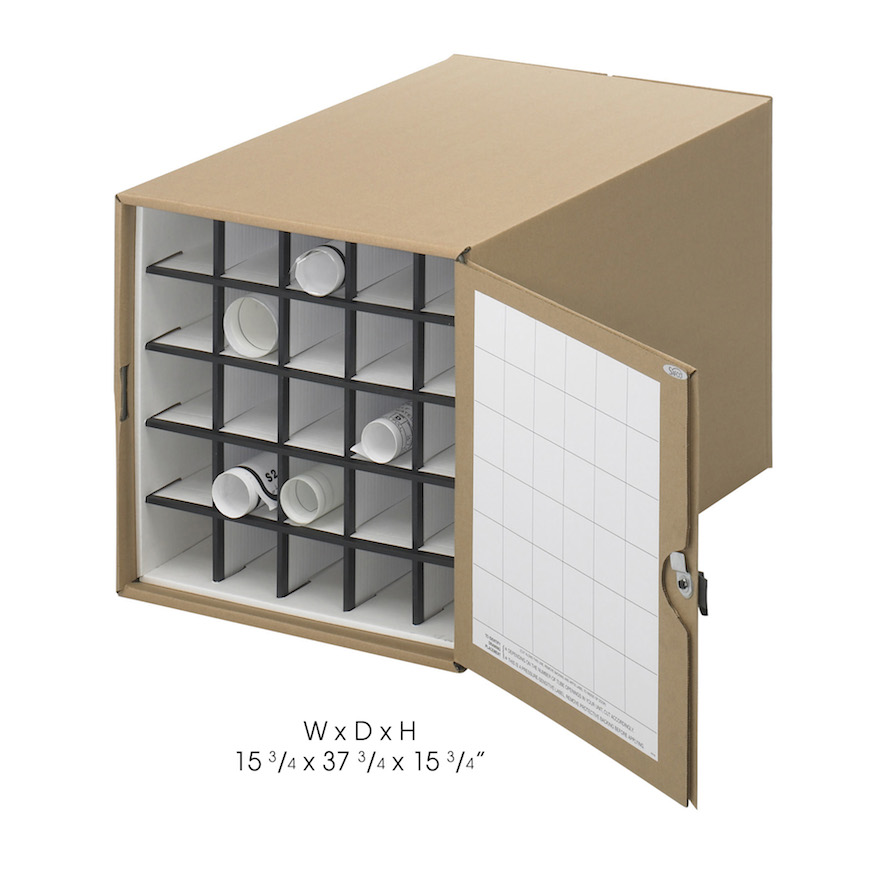Designing for Large Filing: Blueprints and More

We've talked about filing solutions for normal office papers—but what if the papers the end-users are dealing with are blueprints, maps or other large items?
Flat files are one obvious solution. They're incredibly easy to use—you just put your papers in the drawers (which can easily be labeled so you know what's where). The enclosed structure means the papers are protected from dust, spilled coffee, etc. To a limited degree they files are modular; the ones shown above can be stacked two high, if they're placed on a closed base rather than this open one. There's usually a locking option, if the end users need that level of protection. But they do take a lot of floorspace, and they're heavy; the Facil flat files from Safco weigh 118 pounds and up, and that excludes the base. So end users aren't going to casually move these around.

On the other end of the spectrum, there's the mobile trolley, such as the Hang-A-Plan from Arnos. Vertical storage like this takes less floor space, and the trolleys are easy to move around (as long as you don't need to go up or down some stairs). With this design, the binders that hang from the trolley hold up to 150 papers, with no need to add strips or holes.

The Offset Rack from Jalema is available as a two-tier unit—an interesting option for end-users with nine feet of clearance, and a collection of documents they don't need to access very often. Jalema uses staple strips—a reasonable option for archive-type storage, where the end user doesn't need to add or remove documents from the bundle. Color-coded index tabs are available to help end-users find the files they need.

For end-users with the available wall space, there are designs such as this Pivot Wall Rack from Brookside Design, with a maximum capacity of 1,200 sheets. The mounting holes are stud-spaced. If end-users are unable to locate wall studs, Brookside recommends using hollow wall screw anchors rather than the one-inch screws used when mounting to wall studs.

A wall-mounted rack could also hold the sheets parallel to the wall, as with this Drop Lift Wall Rack, which also holds 1,200 documents.

Another design, the Vis-I-Rack, allows rolled plans to be stored on a wall-mounted rack. In the photo above, you'll see the wall supports, which come with 24 pre-drilled holes. I'm all in favor of anything which makes installation easier, having seen too many wall-mounted systems (of various sorts) sitting around, uninstalled. This is not a rack to use anywhere it's likely to get jostled, since it would be easy for the plans to go flying.

Rolled files can also be kept in rolling carts. Note that this one has steps, helping to keep all the files visible.

Another option for end-users with rolled files is an enclosed box, helping to keep the files clean. A nice design detail: the chart on the door, where end users can note which file is in which space.

To help end users find their rolled files, some sort of label/tag system is a good idea; this one is ROLLabels. And to preserve rolled files over the years, end users might want to consider acid-free storage boxes.

In some workspaces, a rack system the hangs from partition walls would be useful. This rack from Safco holds up to 600 sheets.

And here's an interesting design: a plan rack designed to allow end-users to carry rolled blueprints and such in their cars or trucks. The rack can be removed and reinstalled in under 30 seconds (or so they claim) and has an integrated handle—so the whole thing can be removed and carried where needed when the end-users arrive at their destinations.

Here's a variation on the flat file that I started this post with: giant stacking trays. This kind of storage option still takes space, but it has the advantage of being extremely modular; end users can add and remove trays as their needs change. (The trays can be stacked up to five feet high.) These Safco trays are "molded in one piece from high-density polyethylene with steel reinforcement for rigid support and strength."

For end-users who like the idea of an enclosed flat file but want to save floor space, there are vertical files. Some of these (but not the one above) also have fireproofing features.

Using Index/Out Guides for vertical files can help ensure the files that have been so carefully stored can be found—even when someone's removed the file from storage, assuming the end users are good about logging their activities.
-
oFavorite This
-
QComment
K
{Welcome
Create a Core77 Account
Already have an account? Sign In
By creating a Core77 account you confirm that you accept the Terms of Use
K
Reset Password
Please enter your email and we will send an email to reset your password.

